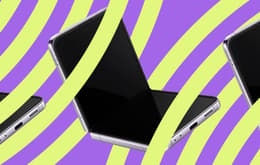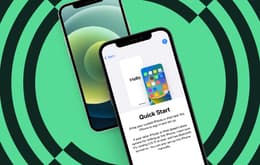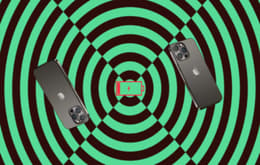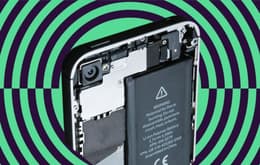
How to get water out of your phone in 4 steps
Updated on May 8, 2024
May 8, 2024
5 mins read
Miguel Garza
Sr. Tech Copywriter (US)
Here’s how to get water out of your phone: Move it to a dry place, turn it off right away, remove any wet parts, and gently dry the ports. Remember to skip the rice. It’s bad for your phone, and it doesn’t work. Try silica gel packets instead.
We’ve all felt the panic of a waterlogged phone. Whether you dropped it in a pool, a puddle, or a toilet — here is how to get water out of your phone in 4 simple steps.
Full disclosure: We do not recommend any solutions involving rice. The rice method is popular, but experts warn against drying your phone this way. It isn’t effective, and the rice can even get stuck in your phone’s ports, worsening the damage.
Even waterproof phones can fall victim to moisture if it’s exposed for too long. When it comes to a water-damaged phone, it’s best to play it safe and complete these steps.
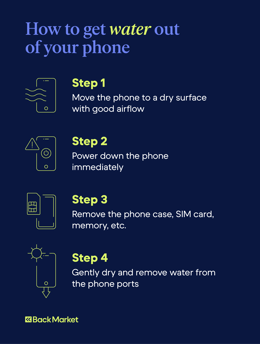
Step 2: Turn the phone off
Cut the power to your phone as soon as possible. This step helps prevent further damage and increases the chance of recovery.
Water and electricity don't mix, and powering on a wet phone increases the risk of short circuits and other internal damage.
You should also keep the phone ports clear. Avoid plugging anything into your phone, like a charger, headphones, etc.
Pro tip: If your touch screen or phone buttons are unresponsive, try using voice-activated features like Siri or Google Assistant to turn off your phone.
Step 3: Remove the phone case and other components
Most modern smartphones come with a fully sealed design, but there are a few components users can remove to aid in the drying process. If your phone is in a case, take that off right away.
Removing the memory card can help prevent potential data loss. And you should also gently remove the SIM card to increase airflow to the internal components.
When it comes to the battery, removing it yourself isn’t always recommended. But, if you can easily remove the battery, you should do so at this stage.
Pro tip: The SIM card is often located on the side of the phone, and you can eject it by piercing a small pinhole. If you don’t have an ejector tool, try using a straightened paper clip.
Step 4: Gently remove water from your phone
Once you’ve prepped your phone, gently dry the exterior with a soft cloth. Avoid inserting a cloth or Q-tips into the ports, as this can push more water into the phone.
To remove water from the phone interior, gently tap the charging port against the palm of your hand. Set your phone with the charging port facing down so excess liquid can drain out over time. You can do this by leaning your phone against a wall or other object.
Leave your phone this way for at least 24 hours. The internal elements could even take a couple of days to completely dry. If your phone turns back on, keep an eye on it for any lingering issues.
Pro tip: Position a fan near the phone to increase gentle airflow. You can also use silica gel packs to help absorb additional moisture.
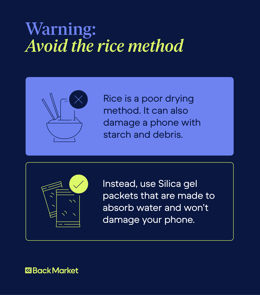
How do you get water out of your phone without rice?
Unlike rice, silica gel packets are specifically for absorbing water. These are the little white pouches commonly found in shoe boxes, medicine bottles, and other product packaging.
Follow these steps:
Collect enough silica gel packets to surround your phone. You can find them at craft stores or online retailers.
Place your phone and the silica gel packets into a sealable bag or container. The sealed environment enhances the effectiveness of the silica gel.
Seal the container tightly, preventing any external moisture from entering and allowing the silica gel to work its magic.
Allow the phone to sit in the sealed bag with the silica gel packets for at least 24 hours.
How do you get water out of your phone speaker?
If your speakers were fully submerged, turn off the phone and let it air dry on an incline with the speaker pointing down. This allows excess water to escape.
Some manufacturers include water-evacuating features that use specific sound frequencies to push water out of the speakers. If the water damage is minimal and limited to the speakers, you can attempt to solve the problem yourself.
Follow the tips below:
Increase your phone's volume to the maximum level and place it at an angle so gravity pulls water from the speaker.
Choose a sound with intense, low vibrations, or use a free frequency on YouTube.
Play the frequency for a few minutes. If the issue persists, repeat the process until your audio no longer sounds muffled.
How do you get water out of your phone charging port?
Even if your phone wasn’t fully submerged, water can still enter the charging port through droplets or prolonged steam exposure. Signs of water in the charging port include no charging activity at all, intermittent charging issues, or visible moisture within the port itself.
While some sources recommend tips to speed up the drying process, good old-fashioned patience and gravity are your best friends in this scenario.
Steps you can take:
Turn off your phone and inspect the charging port.
Gently dry the entire phone with a lint-free cloth.
Place it at an angle so water can slide out of the port.
Wait at least a few hours before attempting to charge it again.
Avoid using hair dryers, compressed air, or Q-tips to force the water out.
When to replace a water-damaged phone
Unfortunately, not all water-damaged phones are salvageable. If your phone has suffered severe water exposure, especially if it involved saltwater, the chances of irreversible damage are higher.
Signs to look for:
No phone power at all
Erratic behavior or glitches
No charging at all or continuous charging issues
Audio disruptions or glitches
Touchscreen or button malfunctions
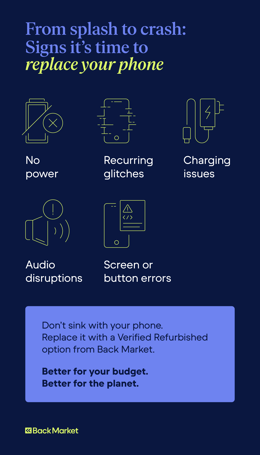
If you’re wondering how to get water out of a phone, it’s a good idea to check the manufacturer’s warranty. Water damage is usually not covered, but it’s best to double-check.
Unexpectedly parting with a device you rely on is never easy. If you need an affordable and reliable replacement, consider a top-of-the-line refurbished smartphone from Back Market.
Back Market is a Certified B corporation offering verified refurbished tech that’s better for your budget — and better for the planet. Electronic waste is a major environmental concern, so we’ll even accept your old phone and make sure it’s recycled responsibly.
Written by Miguel Garza, Sr. Tech Copywriter (US)
Miguel is always looking for new ways to provide unique perspective on popular tech and has taken his writing to the refurbished industry to promote sustainability. Outside of creating content, you might find him travelling the globe, coaching a fitness class, or cheering on his favorite sports teams (Go Dolphins!)








